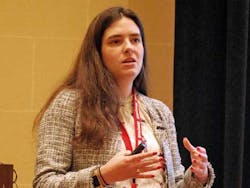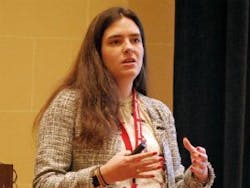“We’re seeing a 50% loss of SMEs in the next five to 10 years. How are we going to deal with our SMEs retiring?” Honeywell UOP’s Katie Jones explained how Process Reliability Advisor is helping facilities to address people, process and technology issues at Honeywell Users Group Americas 2018 in San Antonio.
Refineries and petrochemical producers desire peak performance. They track it and hunt it like wild game. Every day is an opportunity to reduce downtime, improve underperforming assets and address the challenges introduced by the human element.
Since the end of 2014, as crude oil prices dramatically shifted, many operating companies have scaled back investments in new equipment and technology. As they run closer and closer to constraints, assets become more likely to break down, making an unplanned shutdown more likely. This has a profound effect on peak performance, not to mention the bottom line.
If producers could detect and solve potential problems before they occurred, while optimizing engineering capacity and operations, the spoils of the hunt would be much more bountiful. Increasingly, operating companies are looking at new data-related technologies to attack these critical problems.
“Over the past year, we’ve seen some tremendous changes in the industry,” explained Katie Jones, senior product line manager, Connected Performance Services, Honeywell UOP, during her presentation at Honeywell Users Group Americas 2018 in San Antonio. “The industry is looking to apply IoT or Industry 4.0 in order to access data like we’ve never done before.” Jones cited the convergence of key technologies, including digitalization, analytics, virtual reality, connectivity and the cloud, as an opportunity to match tools with expertise to achieve gains that weren’t possible until now.
“It’s changing day by day, month by month,” she said. “Through our communications with our core customers at UOP, we’re hearing similar challenges, such as reactive maintenance practices and the retirement of subject-matter experts (SMEs). We’re seeing a 50% loss of SMEs in the next five to 10 years. How are we going to deal with our SMEs retiring?”
The concept of using a cloud-based platform is quickly becoming the foundation for connected solutions and services that address these kinds of customer needs, providing performance through the most advanced monitoring, analytical and predictive capabilities.
“We can address these issues and enable our customers through the Honeywell Connected Plant,” said Jones. “We’re committed. Each of our organizations has a connected aspect that we’re unifying under the Honeywell Sentience IoT Platform.
“But we’re not starting from zero,” Jones added. “We have an extensive number of existing products and services, enabling our customers to better understand processes, assets and people. We’re elevating those into a connected solution.”
From 100 years to $1 million
UOP is a process technology provider in the oil & gas, refining and petrochemicals space. “We’ve been around more than 100 years,” said Jones. The two primary Honeywell Connected Plant solutions that UOP brings to its customers are Process Optimization Advisor, which maximizes profitability through evaluation and analysis of process changes, and Process Reliability Advisor. “Process Reliability Advisor is used to preempt process issues with embedded root cause analysis,” said Jones. “It can help facilities to operate closer to constraints and can drive best operating practices.” It can be tuned and configured to match your operation, so it acts as a digital twin.
“We also embed in the Advisors a fault model that reflects work we’ve done to model how your specific yields or production rates are affected,” explained Jones. “This enables our customers to get actionable recommendations and push more feed through those units.”
In the cloud-platform architecture, Process Reliability Advisor can take process and lab data from the historian. “It’s a read-only access point,” Jones assured. “It’s an open-configuration architecture. We pull that into the cloud, remove any outlier errors, and make sure the data’s in good condition. Then the results are translated into a visualization layer, which customers have access to.”
One Process Reliability Advisor user that Jones shared was Al Waha Petrochemicals in Saudi Arabia, which produces 450,000 metric tons per year of polypropylene.
“In the first month, we uncovered more than $1 million by relaxing the constraints and improving effectiveness,” said Jones. The outcomes were realized by analyzing and validating cold-box constraints and providing operational guidance to improve production, as well as using the process model to identify gaps and mitigate operational risks.
“Our customers that are using Process Reliability Advisor are driving and improving their profitability,” said Jones. “We’re doing that through a proactive engagement supported by the dashboards on the screens and our service as well. And we’re doing this through three key areas—rigorous process models, tuned kinetic models and fault models with embedded UOP insights.”
With 37 engagements currently underway across the world from the Americas to Asia, that number is more than double the engaged units from a year ago. “In many cases, our customers are operating conservatively,” said Jones. “We work with them to understand and provide recommendations, but they have to be comfortable with any changes. At the end of the day, we want to improve reliability.”
About the Author
Mike Bacidore
Mike Bacidore

Leaders relevant to this article:


